13.3: Savanna Biome
- Page ID
- 16153
\( \newcommand{\vecs}[1]{\overset { \scriptstyle \rightharpoonup} {\mathbf{#1}} } \)
\( \newcommand{\vecd}[1]{\overset{-\!-\!\rightharpoonup}{\vphantom{a}\smash {#1}}} \)
\( \newcommand{\dsum}{\displaystyle\sum\limits} \)
\( \newcommand{\dint}{\displaystyle\int\limits} \)
\( \newcommand{\dlim}{\displaystyle\lim\limits} \)
\( \newcommand{\id}{\mathrm{id}}\) \( \newcommand{\Span}{\mathrm{span}}\)
( \newcommand{\kernel}{\mathrm{null}\,}\) \( \newcommand{\range}{\mathrm{range}\,}\)
\( \newcommand{\RealPart}{\mathrm{Re}}\) \( \newcommand{\ImaginaryPart}{\mathrm{Im}}\)
\( \newcommand{\Argument}{\mathrm{Arg}}\) \( \newcommand{\norm}[1]{\| #1 \|}\)
\( \newcommand{\inner}[2]{\langle #1, #2 \rangle}\)
\( \newcommand{\Span}{\mathrm{span}}\)
\( \newcommand{\id}{\mathrm{id}}\)
\( \newcommand{\Span}{\mathrm{span}}\)
\( \newcommand{\kernel}{\mathrm{null}\,}\)
\( \newcommand{\range}{\mathrm{range}\,}\)
\( \newcommand{\RealPart}{\mathrm{Re}}\)
\( \newcommand{\ImaginaryPart}{\mathrm{Im}}\)
\( \newcommand{\Argument}{\mathrm{Arg}}\)
\( \newcommand{\norm}[1]{\| #1 \|}\)
\( \newcommand{\inner}[2]{\langle #1, #2 \rangle}\)
\( \newcommand{\Span}{\mathrm{span}}\) \( \newcommand{\AA}{\unicode[.8,0]{x212B}}\)
\( \newcommand{\vectorA}[1]{\vec{#1}} % arrow\)
\( \newcommand{\vectorAt}[1]{\vec{\text{#1}}} % arrow\)
\( \newcommand{\vectorB}[1]{\overset { \scriptstyle \rightharpoonup} {\mathbf{#1}} } \)
\( \newcommand{\vectorC}[1]{\textbf{#1}} \)
\( \newcommand{\vectorD}[1]{\overrightarrow{#1}} \)
\( \newcommand{\vectorDt}[1]{\overrightarrow{\text{#1}}} \)
\( \newcommand{\vectE}[1]{\overset{-\!-\!\rightharpoonup}{\vphantom{a}\smash{\mathbf {#1}}}} \)
\( \newcommand{\vecs}[1]{\overset { \scriptstyle \rightharpoonup} {\mathbf{#1}} } \)
\( \newcommand{\vecd}[1]{\overset{-\!-\!\rightharpoonup}{\vphantom{a}\smash {#1}}} \)
\(\newcommand{\avec}{\mathbf a}\) \(\newcommand{\bvec}{\mathbf b}\) \(\newcommand{\cvec}{\mathbf c}\) \(\newcommand{\dvec}{\mathbf d}\) \(\newcommand{\dtil}{\widetilde{\mathbf d}}\) \(\newcommand{\evec}{\mathbf e}\) \(\newcommand{\fvec}{\mathbf f}\) \(\newcommand{\nvec}{\mathbf n}\) \(\newcommand{\pvec}{\mathbf p}\) \(\newcommand{\qvec}{\mathbf q}\) \(\newcommand{\svec}{\mathbf s}\) \(\newcommand{\tvec}{\mathbf t}\) \(\newcommand{\uvec}{\mathbf u}\) \(\newcommand{\vvec}{\mathbf v}\) \(\newcommand{\wvec}{\mathbf w}\) \(\newcommand{\xvec}{\mathbf x}\) \(\newcommand{\yvec}{\mathbf y}\) \(\newcommand{\zvec}{\mathbf z}\) \(\newcommand{\rvec}{\mathbf r}\) \(\newcommand{\mvec}{\mathbf m}\) \(\newcommand{\zerovec}{\mathbf 0}\) \(\newcommand{\onevec}{\mathbf 1}\) \(\newcommand{\real}{\mathbb R}\) \(\newcommand{\twovec}[2]{\left[\begin{array}{r}#1 \\ #2 \end{array}\right]}\) \(\newcommand{\ctwovec}[2]{\left[\begin{array}{c}#1 \\ #2 \end{array}\right]}\) \(\newcommand{\threevec}[3]{\left[\begin{array}{r}#1 \\ #2 \\ #3 \end{array}\right]}\) \(\newcommand{\cthreevec}[3]{\left[\begin{array}{c}#1 \\ #2 \\ #3 \end{array}\right]}\) \(\newcommand{\fourvec}[4]{\left[\begin{array}{r}#1 \\ #2 \\ #3 \\ #4 \end{array}\right]}\) \(\newcommand{\cfourvec}[4]{\left[\begin{array}{c}#1 \\ #2 \\ #3 \\ #4 \end{array}\right]}\) \(\newcommand{\fivevec}[5]{\left[\begin{array}{r}#1 \\ #2 \\ #3 \\ #4 \\ #5 \\ \end{array}\right]}\) \(\newcommand{\cfivevec}[5]{\left[\begin{array}{c}#1 \\ #2 \\ #3 \\ #4 \\ #5 \\ \end{array}\right]}\) \(\newcommand{\mattwo}[4]{\left[\begin{array}{rr}#1 \amp #2 \\ #3 \amp #4 \\ \end{array}\right]}\) \(\newcommand{\laspan}[1]{\text{Span}\{#1\}}\) \(\newcommand{\bcal}{\cal B}\) \(\newcommand{\ccal}{\cal C}\) \(\newcommand{\scal}{\cal S}\) \(\newcommand{\wcal}{\cal W}\) \(\newcommand{\ecal}{\cal E}\) \(\newcommand{\coords}[2]{\left\{#1\right\}_{#2}}\) \(\newcommand{\gray}[1]{\color{gray}{#1}}\) \(\newcommand{\lgray}[1]{\color{lightgray}{#1}}\) \(\newcommand{\rank}{\operatorname{rank}}\) \(\newcommand{\row}{\text{Row}}\) \(\newcommand{\col}{\text{Col}}\) \(\renewcommand{\row}{\text{Row}}\) \(\newcommand{\nul}{\text{Nul}}\) \(\newcommand{\var}{\text{Var}}\) \(\newcommand{\corr}{\text{corr}}\) \(\newcommand{\len}[1]{\left|#1\right|}\) \(\newcommand{\bbar}{\overline{\bvec}}\) \(\newcommand{\bhat}{\widehat{\bvec}}\) \(\newcommand{\bperp}{\bvec^\perp}\) \(\newcommand{\xhat}{\widehat{\xvec}}\) \(\newcommand{\vhat}{\widehat{\vvec}}\) \(\newcommand{\uhat}{\widehat{\uvec}}\) \(\newcommand{\what}{\widehat{\wvec}}\) \(\newcommand{\Sighat}{\widehat{\Sigma}}\) \(\newcommand{\lt}{<}\) \(\newcommand{\gt}{>}\) \(\newcommand{\amp}{&}\) \(\definecolor{fillinmathshade}{gray}{0.9}\)The Savanna biome is characterized by an extensive cover of grasses with scattered trees. It is a transitional biome between those dominated by forests and those dominated by grasses. The Savanna biome is associated with climates having seasonal precipitation accompanied with a seasonal drought. A midlatitude variant, the parkland, is located in the drier portions of the humid continental climate.
Tropical Savanna
The tropical savanna is generally found in regions dominated by the Wet-Dry Tropical climate. An extensive cover of tall grasses, sometimes reaching a height of 3 meters, is found in the tropical savanna. Most savanna grass is coarse and grows in tufts with intervening patches of bare ground. Scattered, individual trees or small groves of trees are common. The umbrella shaped Acacia tree is a notable species of the Savanna biome. The acacia tree uses its long tap roots draw water from deep below the surface during the dry season of the savanna. The tree's long thorns are home to small stinging ants, both of which ward off herbivorous animals. Only the giraffe can tolerate the acacia foliage. The tree's small leaves reduce water loss. Its umbrella shape maximizes the exposure of the small leaves to solar radiation.
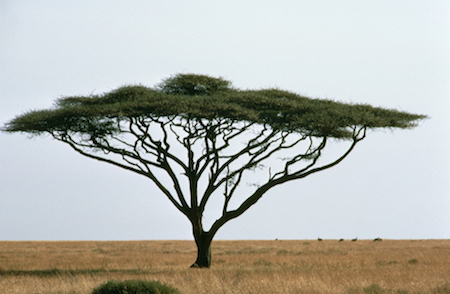
The small amount of high sun rainfall in the savanna is not enough to sustain trees in the savanna biome. Other regional factors play an important role in maintaining the savanna. In eastern Africa where precipitation is higher, savanna vegetation is maintained by periodic fires. Fires burn back the forest and stimulates the growth of grasses like that which occurs in the prairie grasslands. Savannas, like those found in Venezuela and Brazil, develop on soils that have a hard crust and are subject to cracking. Trees flourish where their roots can follow the cracks down to water held deep beneath the surface. Grasses grow in the crust above.
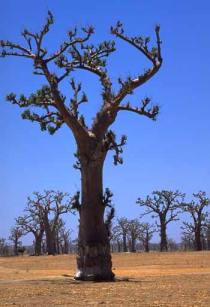
Plants in the savanna have adapted to the long dry season in a number of ways. The Baobab tree stores water in its huge trunk, drawing on the moisture during periods of drought stress. Many grasses and trees of the savanna flourish during the brief wet season and then go into a state of dormancy. Grasses turn brown and trees lose their leaves to reduce the loss of water by transpiration.
A number of different animal species inhabit the tropical savanna like lions, zebras, elephants and giraffes. The long neck of the giraffe is a unique adaptation to the savanna woodlands; its long neck permits browsing on the higher foliage of trees.
Thorntree and Tropical Scrub
The Thorntree and Tropical Scrub is characterized by short, thorny trees and shrubs. The vegetation may form a continuous cover eliminating grasses. This vegetation formation is a response to a longer, and more intense drought period.
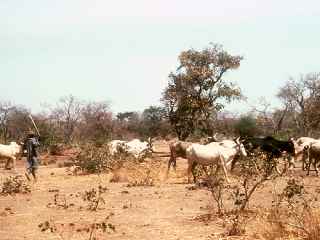
The thorntree and tropical scrub has suffered under the misuse of human activity. Overgrazing has reduced the capacity of the system to withstand the erosive forces of wind, and to a lesser extent water. Without the protective restraint plants, soil and sand, along with valuable soil nutrients, can blow free from the surface. Deserts are rapidly encroaching and replacing the savannas and steppe grasslands. Many years of prolonged drought combined with human pressures on the biome increases the likelihood for desertification of these areas. ![]()
Midlatitude Savanna
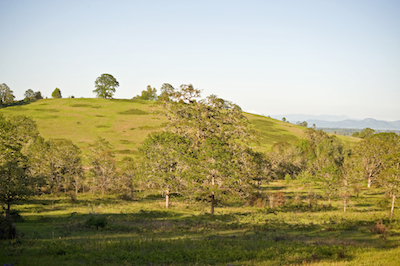
A Midlatitude savanna is sometimes called a parkland. Here, grasses are broken by patches or ribbons of broadleaf trees. The midlatitude savanna is located in a transitional area between the humid continental and midlatitude steppe climates. Parkland often is a step in the successional evolution of plant communities on abandoned farm fields of the eastern United States. For more see "Prairie Parkland (Temperate) Province ".
Human activities and the Savanna Biome
Many animals of the savanna biome like the rhinoceros are endangered and threatened with extinction due to hunting and habitat loss. Most species of elephants are in danger of extinction due to poaching for their ivory tusks. Several means to protect these animals have been tried, even removal of the rhinoceros's horns and the elephant's tusks. Many countries have banned the sale of ivory to discourage poaching under the Convention on International Trade in Endangered Species (Cites) in 1989. The stronger enforcement against poaching nearly brought it to a halt.
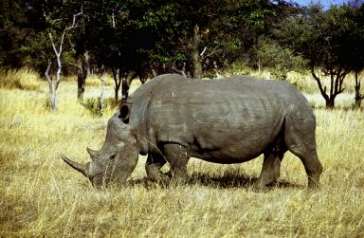
The success of the ban encouraged some countries to negotiate its lifting to sell stockpiled ivory from seizures. A significant increase in elephant poaching has resulted from a substantial rise in the value of ivory. A 2008 research report indicated that African elephant death rate from poaching was at 8 per cent, higher than the 7.4 per cent rate that led to the international ban on ivory trade. African elephant population was estimated at 1 million, with about 70,000 elephants killed each year. In 2008, the population was less than 470,000. At this rate, it is estimated that African elephants could be extinct by 2020. A significant demand in rhino horn as sparked and increase in rhino poaching. In this NPR All Things Considered story from May 13, 2013, Frank Langfett describes how ![]() "Vietnam's Appetite for Rhino Horn Drives Poaching in Aftica". The NPR Morning Edition segment
"Vietnam's Appetite for Rhino Horn Drives Poaching in Aftica". The NPR Morning Edition segment ![]() "Radiocarbon Clues Help Track Down Poached Elephant Ivory" from July 2, 2013 looks out how conservation scientists use high tech means to uncover the source of poached ivory.
"Radiocarbon Clues Help Track Down Poached Elephant Ivory" from July 2, 2013 looks out how conservation scientists use high tech means to uncover the source of poached ivory.
Video: Biomes: Savanna (Courtesy Great Pacific Media)


